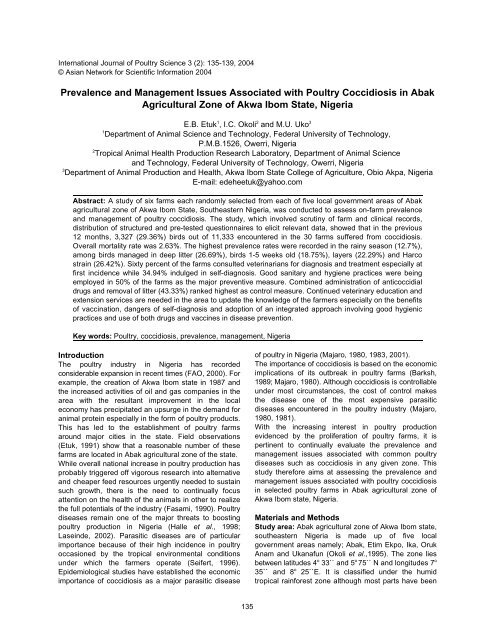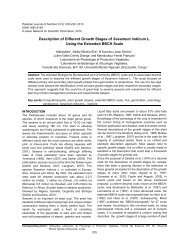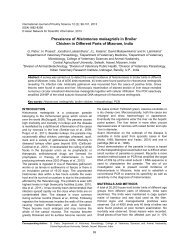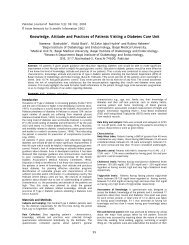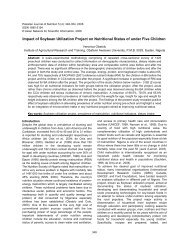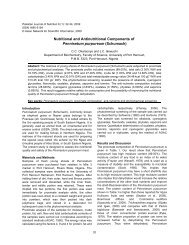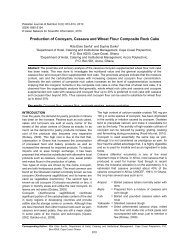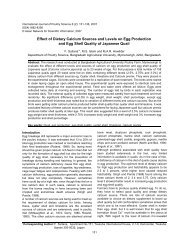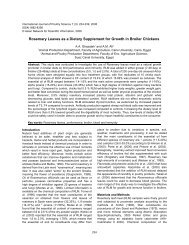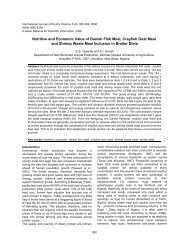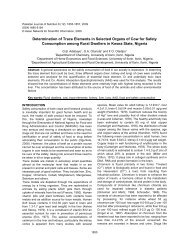Prevalence and Management Issues Associated with Poultry ...
Prevalence and Management Issues Associated with Poultry ...
Prevalence and Management Issues Associated with Poultry ...
You also want an ePaper? Increase the reach of your titles
YUMPU automatically turns print PDFs into web optimized ePapers that Google loves.
International Journal of <strong>Poultry</strong> Science 3 (2): 135-139, 2004<br />
© Asian Network for Scientific Information 2004<br />
<strong>Prevalence</strong> <strong>and</strong> <strong>Management</strong> <strong>Issues</strong> <strong>Associated</strong> <strong>with</strong> <strong>Poultry</strong> Coccidiosis in Abak<br />
Agricultural Zone of Akwa Ibom State, Nigeria<br />
1 2 3<br />
E.B. Etuk , I.C. Okoli <strong>and</strong> M.U. Uko<br />
1<br />
Department of Animal Science <strong>and</strong> Technology, Federal University of Technology,<br />
P.M.B.1526, Owerri, Nigeria<br />
2<br />
Tropical Animal Health Production Research Laboratory, Department of Animal Science<br />
<strong>and</strong> Technology, Federal University of Technology, Owerri, Nigeria<br />
Department of Animal Production <strong>and</strong> Health, Akwa Ibom State College of Agriculture, Obio Akpa, Nigeria<br />
E-mail: edeheetuk@yahoo.com<br />
3<br />
Abstract: A study of six farms each r<strong>and</strong>omly selected from each of five local government areas of Abak<br />
agricultural zone of Akwa Ibom State, Southeastern Nigeria, was conducted to assess on-farm prevalence<br />
<strong>and</strong> management of poultry coccidiosis. The study, which involved scrutiny of farm <strong>and</strong> clinical records,<br />
distribution of structured <strong>and</strong> pre-tested questionnaires to elicit relevant data, showed that in the previous<br />
12 months, 3,327 (29.36%) birds out of 11,333 encountered in the 30 farms suffered from coccidiosis.<br />
Overall mortality rate was 2.63%. The highest prevalence rates were recorded in the rainy season (12.7%),<br />
among birds managed in deep litter (26.69%), birds 1-5 weeks old (18.75%), layers (22.29%) <strong>and</strong> Harco<br />
strain (26.42%). Sixty percent of the farms consulted veterinarians for diagnosis <strong>and</strong> treatment especially at<br />
first incidence while 34.94% indulged in self-diagnosis. Good sanitary <strong>and</strong> hygiene practices were being<br />
employed in 50% of the farms as the major preventive measure. Combined administration of anticoccidial<br />
drugs <strong>and</strong> removal of litter (43.33%) ranked highest as control measure. Continued veterinary education <strong>and</strong><br />
extension services are needed in the area to update the knowledge of the farmers especially on the benefits<br />
of vaccination, dangers of self-diagnosis <strong>and</strong> adoption of an integrated approach involving good hygienic<br />
practices <strong>and</strong> use of both drugs <strong>and</strong> vaccines in disease prevention.<br />
Key words: <strong>Poultry</strong>, coccidiosis, prevalence, management, Nigeria<br />
Introduction<br />
The poultry industry in Nigeria has recorded<br />
considerable expansion in recent times (FAO, 2000). For<br />
example, the creation of Akwa Ibom state in 1987 <strong>and</strong><br />
the increased activities of oil <strong>and</strong> gas companies in the<br />
area <strong>with</strong> the resultant improvement in the local<br />
economy has precipitated an upsurge in the dem<strong>and</strong> for<br />
animal protein especially in the form of poultry products.<br />
This has led to the establishment of poultry farms<br />
around major cities in the state. Field observations<br />
(Etuk, 1991) show that a reasonable number of these<br />
farms are located in Abak agricultural zone of the state.<br />
While overall national increase in poultry production has<br />
probably triggered off vigorous research into alternative<br />
<strong>and</strong> cheaper feed resources urgently needed to sustain<br />
such growth, there is the need to continually focus<br />
attention on the health of the animals in other to realize<br />
the full potentials of the industry (Fasami, 1990). <strong>Poultry</strong><br />
diseases remain one of the major threats to boosting<br />
poultry production in Nigeria (Halle et al., 1998;<br />
Laseinde, 2002). Parasitic diseases are of particular<br />
importance because of their high incidence in poultry<br />
occasioned by the tropical environmental conditions<br />
of poultry in Nigeria (Majaro, 1980, 1983, 2001).<br />
The importance of coccidiosis is based on the economic<br />
implications of its outbreak in poultry farms (Barksh,<br />
1989; Majaro, 1980). Although coccidiosis is controllable<br />
under most circumstances, the cost of control makes<br />
the disease one of the most expensive parasitic<br />
diseases encountered in the poultry industry (Majaro,<br />
1980, 1981).<br />
With the increasing interest in poultry production<br />
evidenced by the proliferation of poultry farms, it is<br />
pertinent to continually evaluate the prevalence <strong>and</strong><br />
management issues associated <strong>with</strong> common poultry<br />
diseases such as coccidiosis in any given zone. This<br />
study therefore aims at assessing the prevalence <strong>and</strong><br />
management issues associated <strong>with</strong> poultry coccidiosis<br />
in selected poultry farms in Abak agricultural zone of<br />
Akwa Ibom state, Nigeria.<br />
Materials <strong>and</strong> Methods<br />
Study area: Abak agricultural zone of Akwa Ibom state,<br />
southeastern Nigeria is made up of five local<br />
government areas namely; Abak, Etim Ekpo, Ika, Oruk<br />
Anam <strong>and</strong> Ukanafun (Okoli et al.,1995). The zone lies<br />
o o o<br />
under which the farmers operate (Seifert, 1996). between latitudes 4 33`` <strong>and</strong> 5 75`` N <strong>and</strong> longitudes 7<br />
o<br />
Epidemiological studies have established the economic 35`` <strong>and</strong> 8 25``E. It is classified under the humid<br />
importance of coccidiosis as a major parasitic disease tropical rainforest zone although most parts have been<br />
135
Etuk et al.: On- farm prevalence <strong>and</strong> management of poultry coccidiosis<br />
modified into oil palm bushes, arable crop farms <strong>and</strong><br />
farm fallows because of agricultural activities <strong>and</strong><br />
population pressure (Ofomata, 1975). There are two<br />
distinct seasons characterized by seven months (April-<br />
October) of wet season <strong>and</strong> five months (November-<br />
March) of dry season. Mean annual rainfall is<br />
o o<br />
3500mm while temperature ranges from 29 C to 33 C.<br />
Rural households keep few sheep, goats, local chicken<br />
<strong>and</strong> pigs. Extensive rearing of started exotic birds is also<br />
becoming popular. The Annang speaking people who<br />
are mainly farmers <strong>and</strong> traders inhabit the area. Major<br />
crops include, yam, cassava, vegetables, <strong>and</strong> cash<br />
crops such as oil palm, citrus, rubber <strong>and</strong> kola nuts.<br />
Data collection: The study involved scrutiny of farm <strong>and</strong><br />
clinical records <strong>and</strong> distribution of structured<br />
questionnaires to farmers <strong>and</strong> their managers, private<br />
<strong>and</strong> government veterinarians <strong>and</strong> agricultural extension<br />
officers to elicit relevant data on farm activities in Abak<br />
agricultural zone over the previous 12 months (March,<br />
1999-February, 2000). Data were obtained from such<br />
key players in thirty poultry farms spread across the five<br />
local government areas of Abak agricultural zone. Six<br />
farms were r<strong>and</strong>omly selected from each local<br />
government area, making 30 farms studied. Structured<br />
questionnaires were developed, pre tested to eliminate<br />
ambiguity <strong>and</strong> then used during scheduled interviews to<br />
elicit relevant information required from the farmers,<br />
managers <strong>and</strong> other key players in the selected farms.<br />
Enough time <strong>and</strong> necessary explanations were offered<br />
to the respondents enabling them to give clear answers<br />
to the questions. Where farmers were not sufficiently<br />
literate, questions were translated into their local<br />
language <strong>and</strong> their responses recorded. All the<br />
questionnaires were correctly completed <strong>and</strong> used for<br />
the analysis. Farm records where available were<br />
scrutinized <strong>and</strong> direct observation on the hygienic<br />
practices in each farm noted.<br />
Clinical records in the study area are generated through<br />
the diagnostic activities of both state <strong>and</strong> private<br />
veterinarians, agricultural extension officers or the<br />
farmers themselves. Among the first three groups of<br />
practitioners, coccidiosis diagnosis usually involves<br />
clinical examination of the flock <strong>and</strong> individual cases,<br />
post mortem <strong>and</strong> parasitological examination of feces<br />
<strong>and</strong> intestinal scrapings. The farmers on the other h<strong>and</strong><br />
usually base diagnosis of coccidiosis on the combined<br />
factors of citing bloody diarrhea from the birds <strong>and</strong><br />
witnessing a positive response of such diarrheic birds<br />
to coccidiosis treatment. The primary draw back of this<br />
practice is probably that only coccidiosis cases<br />
presenting clear bloody diarrhea are diagnosed while<br />
‘occult’ cases are omitted or ascribed to other disease<br />
conditions.<br />
Information generated included, farm location, flock size,<br />
date of visit, poultry species <strong>and</strong> strain <strong>with</strong> specification<br />
of typology (e.g. broiler, cockerel or layer), age, clinical<br />
diagnosis, husb<strong>and</strong>ry details, housing <strong>and</strong> treatment<br />
records.<br />
Data Analysis: Data generated were analyzed using<br />
descriptive statistics <strong>with</strong> emphasis on absolute<br />
distribution <strong>and</strong> percentages. The prevalence of<br />
coccidiosis among the different farm sizes,<br />
strains/breed, typology, age, season <strong>and</strong> management<br />
systems were calculated. Means of percentages of the<br />
different prevalence rates were separated using the<br />
Least Significant Difference (LSD) <strong>and</strong> Student’s T-test<br />
where applicable as outlined by (Steel <strong>and</strong> Torrie, 1980).<br />
Results<br />
Flock distribution <strong>and</strong> characteristics: The distribution<br />
of farm size <strong>and</strong> bird populations is shown in Table 1.<br />
The thirty farms sampled were in 60 flocks <strong>with</strong> a total<br />
bird population of 11,333. Average flock size was 188.8<br />
birds while average bird population per farm was 377.7.<br />
Two farms had over 1000 birds accounting for 49.59% of<br />
total bird population while fourteen farms had 100 <strong>and</strong><br />
below which accounted for only 7.29% of the population.<br />
Farms <strong>with</strong> bird population of 101-500 had an equal<br />
ratio of layers to broilers while those having 501-1000<br />
birds had only layers (Table 2). In all the farms studied,<br />
there was a preponderance of Harco strain of birds<br />
except in farms <strong>with</strong> less than 100 birds.<br />
<strong>Prevalence</strong> of coccidiosis: Based on the data<br />
generated from this study, 3327 of the 11,333 birds were<br />
found to have suffered coccidiosis during the previous<br />
12 months (March, 1999 to February, 2000), giving a<br />
prevalence rate of 29.36% <strong>with</strong> 2.63% mortality (Table 3).<br />
The highest prevalence rate (57.14%) occurred in farms<br />
<strong>with</strong> 501-1000 birds while the least occurrence (12.94%)<br />
was recorded in farms <strong>with</strong> 101-500 birds. Mortality<br />
resulting from coccidiosis was however highest (8.11%)<br />
in farms <strong>with</strong> less than 100 birds <strong>and</strong> lowest (0.35%) in<br />
farms <strong>with</strong> 1001 birds <strong>and</strong> above.<br />
Overall, age incidence of infection (Table 4a) showed<br />
that birds aged 1 to 5 weeks were the most affected<br />
(18.75%). There was a slightly higher prevalence rate<br />
(12.76%) during the rainy season, which was not<br />
significantly different (P>0.01) from the 11.02% recorded<br />
during the dry season (Table 4b). Correspondingly,<br />
mortality was significantly higher (P
Etuk et al.: On- farm prevalence <strong>and</strong> management of poultry coccidiosis<br />
Table 1: Distribution of poultry farm sizes <strong>and</strong> bird population in Abak Agricultural zone of Akwa Ibom State, Nigeria<br />
Farm Size No. of farms Bird population Average bird population/farm % Total bird population<br />
(No. of birds)<br />
1001 2 5620 2810 49.59<br />
Totals 30 11,333 337.76 100.00<br />
Table 2: Flock characteristics in relation to farm size in Abak Agricultural zone of Akwa Ibom State, Nigeria*<br />
Farm size Type of birds Breed/Strain<br />
(No. of birds) ---------------------------------------- ------------------------------------------------------------------------------------<br />
Layers Broilers Harco Anak Cobb Unspecified<br />
< 100 354 (42.86) 472 (57.14) 319 (38.62) _ _ 507 (61.38)<br />
101-500 1286 (45.36) 1551 (54.64) 1240 (43.71) 350 (12.33) 500 (17.62) 747 (26.34)<br />
501-1000 2050 (100.00) _ 2050 (100.00) _ _ _<br />
> 1001 3620 (64.42) 2000 (35.49) 3620 (64.42) 2000 (35.49) _ _<br />
Totals 7310 (65.50) 4023 (35.49) 7229 (63.78) 2350 (20.73) 500 (4.41) 1254 (11.06)*<br />
* Values between brackets represent percentage of birds <strong>with</strong>in total sample population<br />
rate (22.29%) <strong>and</strong> mortality (7.05%) than broilers (3.51%<br />
<strong>and</strong> 1.43% for morbidity <strong>and</strong> mortality respectively)<br />
(Table 5b).<br />
Diagnosis, prevention <strong>and</strong> control of coccidiosis: Sixty<br />
percent of the farms employ the services of veterinarians<br />
in diagnosing the disease condition, 34.44% indulged<br />
in self-diagnosis while 6.66% employed the services of<br />
agricultural extension agents (Table 6a). Again, Table 6b<br />
shows that the farmers <strong>and</strong> managers had considerable<br />
knowledge of the disease. Fifty percent of the farms<br />
employed good sanitation <strong>and</strong> hygiene as preventive<br />
measures, 33.33% administered prophylactic doses of<br />
anticoccidial drugs while 10% used antibiotics. None of<br />
the farms carry out vaccination as a preventive measure<br />
against the disease. Table 6c shows that farmers in<br />
the study area employed different measures either<br />
solely or in combination to control outbreaks. Forty<br />
percent of the farms use anticoccidial drugs while<br />
43.33% administer anticoccidial drugs in addition to<br />
removal of litter. Only 6.66% consulted veterinarians after<br />
the first outbreak of the disease. Another 3.33% of the<br />
farms control the disease by disposing of infected birds<br />
while 3.33% employed local remedies to control the<br />
disease.<br />
Discussion<br />
Infection <strong>with</strong> species of the genus Eimeria, the<br />
causative agents of coccidiosis in poultry has been<br />
shown to be due to E. tenella, E. necatrix, E. brunetti <strong>and</strong><br />
E. acervulina among others in Nigeria (Majaro, 1980,<br />
1981, 1983). These coccidia organisms have been<br />
widely studied as regards morphology, life cycle,<br />
pathogenicity <strong>and</strong> agents of spread. A recent study<br />
(Majaro, 2001) highlighted the role of the common<br />
housefly in the mechanical spreading of coccidiosis,<br />
thus predisposing even birds in new houses to<br />
outbreaks. Coccidiosis is usually controlled by the<br />
inclusion of anticoccidial drugs in feed <strong>and</strong> drinking<br />
water. Due to the acquisition of resistance by Eimeria<br />
species, many compounds in use today are however;<br />
less effective than when they were first introduced<br />
(Chapman, 1997; Chapman, 1999). Coccidiosis<br />
therefore remains a very important limiting health<br />
problem in intensive poultry husb<strong>and</strong>ry in Nigeria<br />
(Majaro, 2001, 2002).<br />
The present study reveals a moderately high prevalence<br />
rate of coccidiosis in poultry farms in Abak agricultural<br />
zone of Akwa Ibom state, Nigeria. This is in agreement<br />
<strong>with</strong> earlier reports of 36-43% prevalence rates for E.<br />
acervulina in other parts of southern Nigeria (Majaro,<br />
1980, 1981). Good sanitary measures <strong>and</strong> prophylactic<br />
treatment reported here among farmers in the zone may<br />
have aided the lower prevalence rates obtained in the<br />
farms. Such measures have been shown to reduce the<br />
incidence rates of coccidiosis outbreaks in poultry farms<br />
(Chapman, 2000; Seneviratha, 1979).<br />
The higher prevalence rate of coccidiosis during the<br />
rainy season agrees <strong>with</strong> earlier reports that the disease<br />
incidence is positively influenced by the warm <strong>and</strong><br />
humid weather, which characterizes the rainy season<br />
period by providing favorable conditions for the growth<br />
<strong>and</strong> development of the infective oocysts (Alawa et al.,<br />
2001; Halle, 1998; Oluyemi <strong>and</strong> Roberts, 1979).<br />
However, prevalence rate during the dry season did not<br />
show any significant difference (P>0.01) from that of the<br />
rainy season. This also agrees <strong>with</strong> the report that<br />
exposure potential of chicken to coccidia parasites in<br />
warm humid tropical conditions is high, since<br />
environmental conditions favor an all year round<br />
137
Etuk et al.: On- farm prevalence <strong>and</strong> management of poultry coccidiosis<br />
Table 3: Influence of farm size on the prevalence of<br />
coccidiosis in Abak Agricultural zone of Akwa<br />
Ibom State, Nigeria*<br />
Farm size Morbidity Mortality<br />
a a<br />
< 100 180 (21.79) 67 (8.11)<br />
a b<br />
101-500 367 (12.94) 51 (1.80)<br />
b a<br />
501-1000 1180 (57.56) 160 (7.80)<br />
a b<br />
> 1001 1150 (20.46) 20 (0.35)<br />
SEM 9.98 2.00<br />
Totals 3327 (29.36)** 290 (2.63)**<br />
*Values between brackets represent percentage of birds<br />
<strong>with</strong>in farm size group. SEM = St<strong>and</strong>ard error of Mean.<br />
**Values between brackets represent percentage of<br />
birds <strong>with</strong>in total sample population. a,b: means <strong>with</strong><br />
different superscripts are significantly different (P21<br />
b<br />
5.11 NA<br />
SEM 3.43 _<br />
(b) Season<br />
Rainy season<br />
a<br />
12.76<br />
a<br />
0.72<br />
Dry season<br />
a<br />
11.02<br />
b<br />
0.48<br />
T- test cal<br />
0.48<br />
18.60<br />
(c ) <strong>Management</strong> System<br />
Deep litter<br />
a<br />
26.69<br />
a<br />
2.66<br />
Battery cage<br />
b<br />
8.34<br />
b<br />
0.00<br />
T-test cal<br />
5.68 10.64<br />
T-test (0.01) = 2.998. SEM = St<strong>and</strong>ard error of Mean.<br />
tab<br />
NA = Not available<br />
development of the coccidial organisms (Obasi et al.,<br />
2001). Generally, our prevalence rates during both<br />
seasons were lower than the 51.5-97.6% earlier<br />
reported for Zaria <strong>and</strong> Makurdi in Northern Nigeria (Halle<br />
et al., 1998; Uza et al., 2001).<br />
Birds managed on deep litter showed higher incidence<br />
of coccidiosis due perhaps to their close contact <strong>with</strong> the<br />
infective oocysts in the litter. Coccidiosis was also most<br />
prevalent among young chicks of 1-5 weeks of age. This<br />
again agrees <strong>with</strong> the report that oocysts could appear<br />
in faecal sample of birds as early as 7 days of age <strong>with</strong><br />
th<br />
the clinical disease manifesting by the 4 week (Majaro,<br />
2001; Obasi et al., 2001). This early infection has been<br />
shown to be partly due to the activities of flies attracted<br />
by the odour of feeds. These flies contaminate the feeds<br />
during their feeding activities <strong>with</strong> the resultant infection<br />
of the chicks (Majaro, 2001). Resistance to the<br />
Table 5: <strong>Prevalence</strong> of coccidiosis in relation to<br />
breed/strain <strong>and</strong> typology of bird in Abak<br />
Agricultural zone of Akwa Ibom State, Nigeria<br />
Parameters Morbidity Mortality<br />
(a) Breed/strain<br />
Harco<br />
a<br />
26.42<br />
a<br />
2.39<br />
Anak<br />
b<br />
1.50<br />
b<br />
0.11<br />
Cobb<br />
b<br />
0.08<br />
b<br />
0.00<br />
Unspecified<br />
b<br />
1.34<br />
b<br />
0.50<br />
SEM 6.36 0.55<br />
(b) Typology of bird<br />
Layers<br />
a<br />
22.29<br />
a<br />
7.05<br />
Broilers<br />
b<br />
3.51<br />
b<br />
1.43<br />
T-test cal<br />
36.32 6.06<br />
T-test tab (0.01) = 2.998. SEM = St<strong>and</strong>ard error of Mean.<br />
a,b: means <strong>with</strong> different superscripts are significantly<br />
different (P
Etuk et al.: On- farm prevalence <strong>and</strong> management of poultry coccidiosis<br />
using a combination of chemoprophylaxis <strong>and</strong> good<br />
hygienic practices (Chapman, 2000; Halle et al.,1998;<br />
Obasi <strong>and</strong> Mbagwu, 2000; Uza et al., 2001).<br />
Current efforts towards farm coccidiosis prevention are<br />
relying more on vaccination. Continued education <strong>and</strong><br />
extension services are therefore recommended for<br />
poultry farmers in Abak agricultural zone in order to<br />
update them on the advantages of vaccination <strong>and</strong><br />
adoption of integrated approach involving good hygienic<br />
practices <strong>and</strong> the use of both drugs <strong>and</strong> vaccines to<br />
prevent this disease. Furthermore, self-diagnosis of<br />
common poultry infections such as coccidiosis, which is<br />
being practiced, by a good number of the farmers in the<br />
study area should be discouraged.<br />
References<br />
Alawa, C.B.I., A.K. Mohammed, O.O. Oni, I.A. Adeyinka,<br />
O.S. Lamidi <strong>and</strong> A.M. Adam, 2001. <strong>Prevalence</strong> <strong>and</strong><br />
seasonality of common health problems in Sokoto<br />
Gudali cattle at a beef research station in the Sudan<br />
ecological zone of Nigeria. Nig. J. Anim. Prod., 28:<br />
224-228.<br />
Barksh, T., 1989. <strong>Poultry</strong> parasites <strong>and</strong> diseases.<br />
African farming <strong>and</strong> food processing. Jan/Feb.<br />
Edition. Allen Charles Publishing Ltd. London, p: 13.<br />
Chapman, H.D., 1997. Biochemical, genetic <strong>and</strong> applied<br />
aspects of drug resistance in Eimeria parasite of<br />
the fowl. Avian Path., 26: 221-224.<br />
Chapman, H.D., 1999. Anticoccidial drugs <strong>and</strong> their<br />
effects upon the development of immunity to<br />
Eimeria infection in poultry. Avian Path., 28: 521-<br />
535.<br />
Chapman, H.D., 2000. Practical use of vaccines for the<br />
control of coccidiosis in the chicken. World Poult.<br />
Sci. J., 56: 7-20.<br />
Etuk, E.B., 1991. Survey of the distribution of poultry<br />
farms in Akwa Ibom State, Nigeria. Unpublished.<br />
FAO, 2000. Food <strong>and</strong> Agricultural Organization of the<br />
United Nation, Rome. Quarterly bulletin of statistics,<br />
Vol.1.<br />
Fasami, F., 1990. Nigerian livestock industry <strong>and</strong><br />
prospects for the 1990s. Nig. Inst. Soc. Econ.<br />
Res./Fed. Livest. Prod. Comm. Seminar. Kaduna,<br />
Nigeria.<br />
Halle, P.D., J.U. Umoh, L. Saidu <strong>and</strong> P.A. Abdu, 1998.<br />
Disease of poultry in Zaria, Nigeria: A ten-year<br />
analysis of clinical records. Nig. J. Anim. Prod., 25:<br />
88-92.<br />
Laseinde, E.A.O., 2002. <strong>Poultry</strong>: God’s goldmine in the<br />
livestock industry. An inaugural lecture. Federal<br />
University of Technology, Akure. Classic<br />
Educational Publishers, Akure, Nigeria, pp: 48.<br />
Majaro, O.M., 1980. The epidemiology <strong>and</strong> economic<br />
importance of poultry coccidiosis in Oyo State,<br />
Nigeria. Rev. Elev. Med. Vet. Pays Trop., 33: 377-<br />
379.<br />
Majaro, O.M., 1981. Coccidiosis oocyst from broiler<br />
chickens in Nigeria. Rev. Elev. Med. Vet. Pays Trop.,<br />
34: 23-25.<br />
Majaro, O.M., 1983. <strong>Poultry</strong> coccidiosis: Evaluation of<br />
management systems on the incidence of coccidian<br />
infection in Nigeria. Rev. Elev. Med. Vet. Pays Trop.,<br />
36: 343-346.<br />
Majaro, O.M., 2001. New house syndrome: Investigation<br />
into the possible role of housefly (Musca domestica)<br />
in the epizootiology of coccidiosis in chickens. Trop.<br />
Vet., 19: 237-242.<br />
Majaro, O.M., 2002. Anticoccidial activity of Lasalosid<br />
R<br />
(Avatec) <strong>and</strong> other anticoccidial drugs against<br />
Eimeria acervulina infection <strong>with</strong> particular<br />
reference to oocysts production. Trop. Vet., 20: 48-<br />
51.<br />
Obasi, O.K. <strong>and</strong> H.O.C. Mbagwu, 2000. Coccidiosis <strong>and</strong><br />
th<br />
turkey production in Nigeria. Book of proc. 25 Ann.<br />
Conf. Nig. Soc. Anim. Prod. Umudike, 25: 276-277.<br />
Obasi, O.C., O.J. Ifut <strong>and</strong> E.B. Ekpo, 2001. The response<br />
of naturally infected broiler birds to some br<strong>and</strong>s of<br />
th<br />
anti-coccidials. Proc. 26 Ann. Conf. Nig. Soc. Anim.<br />
Prod., 26: 53-54.<br />
Ofomata, G.E., 1975. Nigeria in Maps: Eastern Nigeria.<br />
pp: 8-9. Ethiope Publishing House, Benin-city.<br />
Okoli, O., C.E. Onyenweaku <strong>and</strong> J.E.G. Ikeorgu, 1995.<br />
Report of southeastern zone livestock sub sector.<br />
Paper presented at the National Agricultural<br />
Strategic Plan for Nigeria, Zaria, Nigeria.<br />
Oluyemi, J.A. <strong>and</strong> F.A. Roberts, 1979. <strong>Poultry</strong> production<br />
in warm wet climate. pp: 141-147. Low cost edition.<br />
Macmillan publishers Ltd. London.<br />
Seneviratha, P., 1979. Disease of poultry including<br />
nd<br />
caged birds. pp: 8-48, 2 edition. British John<br />
Wright, London.<br />
Seifert, H., 1996. Tropical Animal Health. Kluwer<br />
Academic Publishers, Boston/London.<br />
Soulsby, E.J.L., 1987. Immunology, immunopathology<br />
<strong>and</strong> immunoprophylaxis of parasitic infections. Vol.<br />
3, CRC press, Boca Raton.<br />
Steel, G.D.D. <strong>and</strong> J.H. Torrie, 1980. Principles <strong>and</strong><br />
nd<br />
procedures of statistics. 2 ed. McGraw Hill books<br />
Coy Inc. New York.<br />
Uza, D.V., S.A.S. Olorunju <strong>and</strong> J.M.T. Orkpeh, 2001. An<br />
assessment of the disease <strong>and</strong> production status<br />
of indigenous poultry in Benue <strong>and</strong> Nassarawa<br />
th<br />
states of Nigeria. Proc. 26 Ann. Conf. Nig. Soc.<br />
Anim. Prod. Zaria, Nigeria, 26: 73-75.<br />
139


